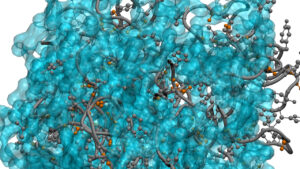Posted on December 7, 2023 in ASRC News, Nanoscience Initiative, Structural Biology Initiative

Based on simple design rules, strings of polypeptides spontaneously form liquid droplets that fluoresce in red and green.
Biological cells play host to hundreds of thousands of proteins that control myriad chemical processes taking place at once. To avoid chaos, these processes need to be tightly regulated so cells can perform life’s essential tasks. And it’s increasingly clear that special liquid droplets composed largely of unstructured proteins are critically important for this cellular regulation to occur. Unlike structured proteins, which are comprised of chain-like biomolecules that are well-folded to form specific stable structures, the disordered protein chains in these liquid droplets are much more dynamic and are simultaneously flexible and sticky.
In a new study, published in Angewandte Chemie, a chemistry journal from Wiley, researchers at the Advanced Science Research Center at the CUNY Graduate Center (CUNY ASRC) set out to design simpler versions of these biomolecular droplets in the lab. Their main challenge was to figure out how to engineer the right balance of flexibility and stickiness in drastically simplified versions of disordered proteins, to create designer peptide droplets.
After studying the properties of droplet-forming proteins shared in published literature, researchers from the labs of Rein Ulijn and Shana Elbaum-Garfinkle honed a simple design to create their own sticky and flexible peptides that form liquid droplets.
“From examples described in literature, we basically extracted design rules and made simpler versions of them,” said Ulijn, the paper’s corresponding author, who is director of the Nanoscience Initiative at the CUNY ASRC and Einstein Professor of Chemistry at Hunter College. “We went into the lab and tested these, and we were able to create liquid droplets based on much simpler peptides, compared to the protein-based structures that we find in biology.”
Simple in Design
The first step in their design was looking at how biology creates droplets and simplifying it as much as possible to extract some general rules. The next step was turning that process into a design principle. Remarkably, the researchers found a simple design that works remarkably well.
These designed polypeptides were composed of very short flexible linkers—which were just three amino acids in length—alternating with amino acids known to have a strong propensity to interact. Several repeats of these modules gave rise to the new polypeptides.
“Imagine these designed peptide molecules as strings composed of different types of beads,” Ulijn said. “On each string there are beads that are sticky, and they are separated by short strands of beads that are flexible.”
Key to the team’s design success was getting the water interactions with the sequences just right, that allowed the molecular strings to become entangled. Next, water was squeezed from these tangled strings which led to spontaneous formation of separated liquid peptide droplets, inside a larger volume of water, much like formation of droplets when oil is mixed with vinegar. The designed peptides can then create liquid droplets in a fashion that is similar to the much more complex proteins found in living systems.
Order and fluorescence
In a second key finding, the researchers discovered that, the degree of chain disorder and flexibility is critical for formation of biomolecular liquid droplets when using these minimalistic peptide designs.
Initially, the researchers thought that the links should be as disordered and flexible as possible, but early designs gave rise to aggregates (too sticky) or solutions (too flexible), not droplets. It turns out that these simplified systems need chains that are significantly dynamic to get the liquid droplets to form. The team was able to engineer this level of order by systematically exchanging amino acids in the modular design, thereby establishing design rules.
Normally researchers would have to add a specific dye to the droplet to observe it using fluorescence microscopy. But in this case, they saw that the droplets were inherently fluorescent, and the fluorescence was determined by the sequence.
“It was quite surprising and exciting to discover that these condensates exhibited such strong natural fluorescence—the wavelength of which are tunable by altering the amino acid sequence,” said Elbaum-Garfinkle, whose lab with the CUNY ASRC Structural Biology Initiative discovered the droplets’ intrinsic fluorescence.
Depending on the selected amino acid sequence, the droplets fluoresced in luminescent green or red, which was fortunate because these are common dye colors used in biological labeling and fluorescence microscopy. This allowed the researchers to observe the droplets directly without adding dye.
Under a microscope
Because the droplets are so readily observable under a microscope, they have significant potential for use in biomedicine, said the researchers. To this end, the group is currently investigating possible applications in drug delivery and cell imaging.
The study also presents valuable insights on the regulation of cells. This is because when a cell’s metabolism goes out of control, it can give rise to various disease states. If protein droplets are important in keeping cell metabolic processes in balance, then simple designed peptide biodroplets could give rise to new types of therapies in maintaining cell regulation in the future.
Project collaborators include first authors Deborah Sementa, a postdoctoral research associate in Ulijn’s lab, and Dhwanit Dave, who recently successfully defended his Chemistry Ph.D. thesis at the Graduate Center and Hunter College. The study was funded by the Air Force Office of Scientific Research, the Department of Defense’s Vannevar Bush Faculty Fellowship, the Graduate Research Training Initiative of the State of New York, and the National Science Foundation.
